Stade Rennais F.C.
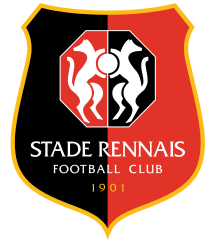 | |||
| Full name |
Stade Rennais Football Club | ||
|---|---|---|---|
| Nickname(s) |
Les Rouges et Noirs (The Red and Blacks) | ||
| Founded | 10 March 1901 | ||
| Ground | Roazhon Park | ||
| Capacity | 29,778[1] | ||
| Owner | Groupe Artémis | ||
| Chairman | Olivier Létang[2] | ||
| Manager | Sabri Lamouchi | ||
| League | Ligue 1 | ||
| 2017–18 | Ligue 1, 5th | ||
| Website | Club website | ||
|
| |||
Stade Rennais Football Club (French pronunciation: [stad ʁɛnɛ]), commonly referred to as Stade Rennais, SRFC or simply Rennes (French pronunciation: [ʁɛn]), is a French association football club based in Rennes. The club was founded in 1901 and currently plays in Ligue 1, the top tier of French football. Rennes plays its home matches at the Roazhon Park, located within the city. The team is managed by Sabri Lamouchi. The team's president is Olivier Létang and its owner is Artémis, the holding company of businessman François Pinault.
Rennes was founded in 1901 under the name Stade Rennais and is one of the founding members of the first division of French football. Alongside Nantes, Rennes is one of the top football clubs in the region and the two are among the main clubs that contest the Derby Breton. The club's best finish in the league has been fourth with the club accomplishing this feat on four occasions, most recently in 2006–07. Rennes has won two Coupe de France titles in 1965 and 1971. After winning the Coupe de France in 1971, Rennes changed its name to its current version.
Rennes is known for its youth academy, known in English as the Henri Guérin Training Centre, which was formed in 2000. The French Football Federation (FFF) has regularly recognised Rennes as having the best youth academy in the country.[3] The cornerstone of the academy is the under-19 team, which has won the Coupe Gambardella three times in 1973, 2003 and 2008. The academy has produced several notable talents, such as Sylvain Wiltord, Yoann Gourcuff, Yann M'Vila, Moussa Sow, Yacine Brahimi, Abdoulaye Doucouré, Ousmane Dembélé and Jimmy Briand, among others.
History
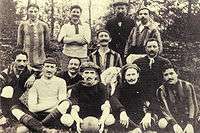
Stade Rennais Football Club was founded on 10 March 1901 by a group of former students living in Brittany. Football had quickly become widely circulated in nearby regions and it was soon brought to Brittany. The club's first match was played two weeks later against FC Rennais, which Stade lost 6–0. In 1902, Stade Rennais joined the USFSA federation and, subsequently, became a founding member of the Ligue de Bretagne de football, a newly created regional league founded by the federation. In the second league season, the club won the competition after defeating the inaugural league winners FC Rennais 4–0 in the final. On 4 May 1904, Stade Rennais merged with its rivals FC Rennais to form Stade Rennais Université Club, with the primary objective being to overcome the recent domination of the Ligue de Bretagne by US Saint-Malo, then known as US Saint-Servan, which fielded mostly British players.[4] The new club adopted the colours of Rennais, which consisted of a red and black combination with black vertical stripes on the shirt. After three years of Saint-Malo dominating the league, Rennes finally eclipsed the club in 1908 under the leadership of Welsh manager Arthur Griffith. In the following season, Rennes won the league again, but in 1910 Rennes was unable to win a third, as Saint-Malo won the league by two points. The champions subsequently went on an impressive run in which it won the league for the next four seasons over.
After World War I, Rennes began focusing its efforts on winning the recently created Coupe de France. Strengthened by the arrivals of internationals Bernard Lenoble, Maurice Gastiger, Ernest Molles and captain François Hugues after the war, in the competition's fourth campaign, Rennes reached the final. In the match, the club faced two-time defending champions Red Star Olympique, which was led by attacker Paul Nicolas, defender Lucien Gamblin and goalkeeper Pierre Chayriguès. Red Star opened the scoring in the fourth minute and the match was concluded following a late goal from Raymond Sentubéry.[5] After the disorganisation of the USFSA in 1913, Rennes joined the Ligue de l'Ouest. In 1929, Rennes departed the league after disagreeing with the increased number of games the league sought to implement in the new season. The departure led to Rennes becoming a "free agent", and the club played numerous friendly matches to compensate the loss of league matches.
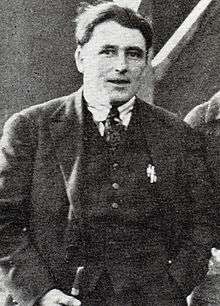
In July 1930, the National Council of the French Football Federation (FFF) voted 128–20 in support of professionalism in French football. Under the leadership of club president Isidore Odorico, Rennes was among the first clubs to adopt the new statute and, subsequently, became professional and became founding members of the new league. In the league's inaugural season, Rennes finished mid-table in its group. Two years later, in 1935, the club reached the final of the Coupe de France for the second time. Rennes, however, lost to Marseille 3–0 after failing to overcome three first-half goals. The club's attack was also limited in the match due to being deprived of its top two attackers, Walter Kaiser and Walter Vollweiler, who were both injured. Rennes spent four more years in the first division before suffering relegation to Division 2 in the 1936–37 season. Rennes played in Division 2 before professionalism was abolished due to World War II. After the war, Rennes returned to Division 1. Led by the Austrian-born Frenchman Franz Pleyer, Rennes achieved its best finish in the league after finishing fourth in the 1948–49 campaign. Despite the domestic resurgence under Pleyer, the club struggled to maintain the consistency and, in the 1950s, rotated between the first division and the second division under the watch of the Spaniard Salvador Artigas and Henri Guérin, who acted in a player-coach role.
Under the leadership of new president Louis Girard, Rennes underwent a major upheaval, which included renovations to the stadium. Girard sought to make Rennes competitive nationally and the first objective was achieved when the club earned promotion back to Division 1 in 1958. After finishing in the bottom-half of the table for six-straight seasons, Rennes, now managed by former club player Jean Prouff, finished in fourth place in the 1964–65 season. In the same season, the club earned its first major honour after winning the Coupe de France. Rennes, led by players such as Daniel Rodighiéro, Georges Lamia and Jean-Claude Lavaud defeated UA Sedan-Torcy 3–1 in the replay of the final. The first leg of the match ended 2–2, which resulted in a replay. After the cup success, Rennes played in European competition for the first time in the 1965–66 season. The club, however, lost to Czechoslovakian club Dukla Prague in the first round.
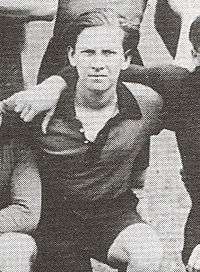
In the ensuing years, Rennes struggled in league play but performed well in the Coupe de France, reaching the semi-finals on two occasions in 1967 and 1970. In 1971, Rennes captured its second Coupe de France title after defeating Lyon 1–0 with the only goal coming from a penalty conversion by André Guy. On 23 May 1972, Rennes officially changed its name to its current form. After another season in charge, Prouff departed Rennes and the club entered free-fall. From 1972 to 1994, Rennes was supervised by 11 different managers and, during the years, consistently hovered between Division 1 and Division 2. In 1978, the club was on the verge of bankruptcy and, as a result, was order by a tribunal to sell its biggest earners and enter a policy of austerity. In the 1980s, the city's municipality gained a majority stake in the club.
In 1994, Rennes returned to Division 1 and entered a period of stability mainly due to the utilisation of the club's youth academy. Instead of entering bidding wars for players, Rennes groomed its youngsters and inserted them onto the senior team when coaches felt they were ready. This strategy proved successful with players such as Sylvain Wiltord, Jocelyn Gourvennec and Ulrich Le Pen. In 1998, the club was sold by the municipality to retail magnate François Pinault. Pinault invested a substantial amount of funding into the club and sought to increase Rennes' production of youth talent by constructing a training centre, which was completed in 2000. Pinault also paid for a completed re-construction of the stadium and also invested in the transfer market, recruiting several players from South America, most notably Lucas Severino, whom Rennes paid a record €21 million for.
The results were immediate in the decade from 2000 to 2010, with Rennes appearing in UEFA-sanctioned European competitions in five of the ten seasons. In youth production, the club produced several youth talents such as Yann M'Vila, Yacine Brahimi, Jimmy Briand and Abdoulaye Diallo, among others. In league competition, Rennes tied its best finish ever in the league by finishing fourth in 2004–05. Two seasons later, the club accomplished this feat again. In 2009, Rennes reached the Coupe de France final for the fourth time in its history. In the final, Rennes faced Breton rival Guingamp and was the heavy favourite. Despite taking the lead in the second half, however, Rennes was defeated 2–1 after Guingamp scored two goals in a ten-minute span. In 2014, Rennes made the Coupe de France final and once again their opponent was Guingamp. In a tense final, Rennes lost the match to their fierce rivals 2-0.[6] In the 2017/2018 Ligue 1 season, Rennes had one of their best campaigns in recent memory finishing 5th and qualifying for the uefa europa league.[7]
Stadium
Rennes has played on the land where the club's stadium, the Roazhon Park, situates itself since 1912. The Roazhon Park, then named Stade de Route de Lorient, which is its address, was constructed in 1912. The facility was inaugurated on 15 September 1912 in a match between Rennes and SA du Lycée de Rennes. The Stade de la Route de Lorient was officially inaugurated a month later when Rennes took on Racing Club de France in front of 3,000 spectators.
The Roazhon Park is owned by the city of Rennes and has undergone renovations three times, in 1955, 1983 and 1999. In 1983, the club renovated the stadium in an attempt to resemble the Olympiastadion in Munich. After nearly four years of renovation, the new stadium was unveiled on 7 March 1987. In 1999, the new renovations, which were designed by architect Bruno Gaudin, cost €37.3 million and took four years to complete. The stadium's inauguration was celebrated twice: in a match between France and Bosnia and Herzegovina in August 2004, and another football match contesting by Rennes and Metz two months later. The current capacity of the stadium is 29,778.[1]
Training centre
The Centre d'entraînement Henri-Guérin (Henri-Guérin Training Center), commonly known as simply La Piverdière, was inaugurated in June 2000. The centre is named after former club player and manager Henri Guérin and is located on the outskirts of the city of Rennes. The centre hosts training sessions of the senior team, as well as the club's reserve and youth teams. Since 2007, the facility has become the headquarters of Stade Rennais football with the club's administrative and commercial duties being conducted at the centre.
Since the centre's foundation, it has become known for its consistent production of youth talent, bringing through players that have become household names at international level. Since 2000, the club's youth system has made up most of the club's first team. In the present day, first-team players Vincent Pajot, Jirès Kembo Ekoko, Yassine Jebbour, Yann M'Vila, Yacine Brahimi, Kévin Théophile-Catherine, Abdoulaye Diallo and Romain Danzé all made the senior team that were graduates of the academy. Rennes has been awarded the honour of having the best youth academy in France.
Rennes has won the Coupe Gambardella, the under-19 national youth competition, three times, in 1973, 2003 and 2008. In 2003, the team that won was anchored by Yoann Gourcuff and Marveaux. Gourcuff has since gone on to win both the UNFP Player of the Year and French Player of the Year awards and establish himself as a French international. Marveaux graduated from the academy after the Gambardella triumph and has gone on to appear in over 100 matches for Rennes. He had his best season to date in the 2009–10 season, appearing in 38 matches and scoring 12 goals. In 2008, the team that won the competition was composed of Brahimi, M'Vila, Souprayen, Yohann Lasimant, Quentin Rouger, Kévin Théophile-Catherine, and Damien Le Tallec. Six of the seven players made appearances with the first-team. Le Tallec moved to German club Borussia Dortmund before he could make an appearance.
Supporters
Rennes have several supporter groups associated with the club, ranging from groups of senior supporters to ultras. The oldest, most structured and frequented is Allez Rennes. The group was founded in 1962 and together with Les Socios, founded in 1992, is the largest group of traditional supporters.
The section of the stadium popularly called Tribune Mordelles is occupied by the Roazhon Celtic Kop (RCK). Although the group was founded in 1991, its roots date back to 1987 when a group of supporters known as Ultras Roazhon was formed. The RCK was formed by three young supporters who decided to establish the Mordelles stand as the true hot spot of the stadium.[8] The group marks its presence not only through continuous singing and the use of flares, but also through numerous tifos and choreographic celebrations. The Breton identity is regularly displayed and the use of Celtic symbols is frequent.[9] A special feat of the RCK is that the group is responsible for having made the largest Gwenn-ha-du in history measuring 270 square metres. It was displayed at the Mordelles stand during the 1994–95 season.[10]
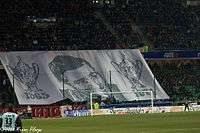
The RCK functions as an unconditional supporters' group present at all matches, including those at European level, and gathers supporters mainly of the ultra-mentality, but also holds on to its values describe by the group as Amitié, Respect et Fête (Friendship, Respect and Party). The Kop keeps an open attitude towards those supporters of Rennes who share them.[11] The group has taken a strong position against "football business", the suppression of the ultra-movement[12] and racism. Although the group is not officially political, it regularly manifests anti-fascism.[13] The RCK is a member of the RSRA (Réseau Supporter de Résistance Antiraciste),[14] a French network of football supporter groups against racism, and involved in Fare, a European network of football supporter groups against racism and discrimination.[15]
Another major supporter group of the club is the Section Roazhon Pariz. It is a section of the RCK that is situated in Paris. The group supports the team at important away matches, such as those against Lyon and Paris Saint-Germain.[16] The RCK makes no attempt to hide its chaotic and festive appearance. In 2003, a second group of ultras, the Breizh Stourmer ("Breton Warriors") was formed through a break with the RCK. The group was created around the idea of a small, strong core of supporters and chose to situate themselves on the opposite side of the RCK. The Breizh Stourmer has been accused by elements of the RCK for certain members holding extreme-right views.[13] Violent clashes between radical members of the two groups have occurred. The main rival of the RCK has, however, not been the Breizh Stourmer, but for many years, the Bridage Loire, a supporters' group of Rennes' rival club Nantes. The Breizh Stourmer has since dissolved. In 2008, a new group of supporters, the Unvez Kelt (UK) ("Celtic Unity"), was founded. The group was initially refused by the club as an official group, however, with the help of Les Socios, it was finally accepted.[17] Failing to establish itself and after several problems, among them a fire that destroyed its premises in November 2010,[18] clashes with the National Police[19] and incidents resulting in several of its members becoming arrested during an away match at Auxerre in 2012,[20] the Unvez Kelt decided to dissolve in 2012.[21]
Players
Current squad
- As of 2 September 2018. [22]
Note: Flags indicate national team as defined under FIFA eligibility rules. Players may hold more than one non-FIFA nationality.
|
|
Out on loan
Note: Flags indicate national team as defined under FIFA eligibility rules. Players may hold more than one non-FIFA nationality.
|
|
Notable players
Below are the notable former and current players who have represented Rennes in league and international competition since the club's foundation in 1901. To appear in the section below, a player must have played in at least 100 official matches for the club.
For a complete list of former Stade Rennais F.C. players with a Wikipedia article, see here.
Management and coaching
- Club officials[23]
- President: René Ruello
- Administrative Director: Olivier Tomine
- Coaching
- Manager: Christian Gourcuff
- Assistant Manager: Laurent Huard
- Youth academy director: Patrick Rampillon
Managerial history
Managers since 1906 and later to the accession to professional status in 1932, with the exception of 1939–1941, where the Stade Rennais reverted to amateur status, and 1942–1944, where no manager was appointed by the board, and 1945 where the club didn't compete in any competition.[24]
|
|
Honours
Domestic
- Ligue 2
- Coupe de France
- Coupe de la Ligue
- Runners-up (1): 2012–13
- Trophée des champions
- Champions (1): 1971
Europe
U19
- Coupe Gambardella
- Champions (3): 1973, 2003, 2008
Stade Rennais FC in European football
References
- Notes
- 1 2 "Stade Rennais F.C. > Infrastructures > Roazhon Park". staderennais.com (in French). Stade Rennais F.C. 2 September 2014. Retrieved 3 August 2014.
- ↑ "Olivier Létang named Rennes President". getfootballnewsfrance.com. 4 November 2017. Retrieved 10 January 2018.
- ↑ "Rennes, champion de France de la formation". MaxiFoot. 9 June 2010. Retrieved 9 January 2011.
- ↑ "Les années 1900: le Stade Rennais voit le jour" (in French). Stade Rennais FC. 15 July 2007. Retrieved 9 January 2011.
- ↑ "Coupe de France: Saison 1921–1922" (in French). French Football Federation. Archived from the original on 8 October 2012. Retrieved 9 January 2011.
- ↑ Gibney, Andrew. "Guingamp Upset Neighbours Rennes by Lifting the 2014 Coupe De France".
- ↑ https://www.uefa.com/uefaeuropaleague/news/newsid=2551855.html
- ↑ "Roazhon Celtic Kop" (in French). Stade Rennais FC. Retrieved 9 January 2011.
- ↑ "Presentation" (in French). Roazhon Celtic Kop. Retrieved 9 January 2011.
- ↑ Leicester University, Sport in the Making of Celtic Cultures (Sport and Nation), Grant, Jarvie, 1999, p.82. ISBN 0-718-50129-2
- ↑ "Presentation" (in French). Roazhon Celtic Kop. Retrieved 5 January 2015.
- ↑ "Roazhon Celtic Kop".
- 1 2 Keltz 2012, p. 115.
- ↑ "Non au racisme - La lutte". www.non-au-racisme.com.
- ↑ "STADE RENNAIS F.C." STADE RENNAIS F.C.
- ↑ "Presentation: Section Roazhon Pariz" (in French). Roazhon Celtic Kop. Retrieved 9 January 2011.
- ↑ "Unvez Kelt" (in French). Stade Rennais FC. Retrieved 9 January 2011.
- ↑ "L'Unvez Kelt sous le choc après un mystérieux incendie".
- ↑ "Supporters et SIR : une cohabitation qui s'annonce difficile".
- ↑ Keltz 2012, p. 121.
- ↑ "Supporters : dissolution des Unvez Kelt".
- ↑ "Equipe Pro" (in French). Stade Rennais FC. Retrieved 20 January 2017.
- ↑ "Organigramme" (in French). Stade Rennais FC. Retrieved 20 August 2013.
- ↑ "Stade Rennais coaches on RSSSF". RSSSF. Retrieved 9 January 2011.
- ↑ Coupe Intertoto 2008 Archived 6 June 2014 at the Wayback Machine.. Listed are all 11 teams that won the Intertoto Cup, qualifying for the UEFA Cup.
- Bibliography
External links
- Official website

- Unofficial website (in English)